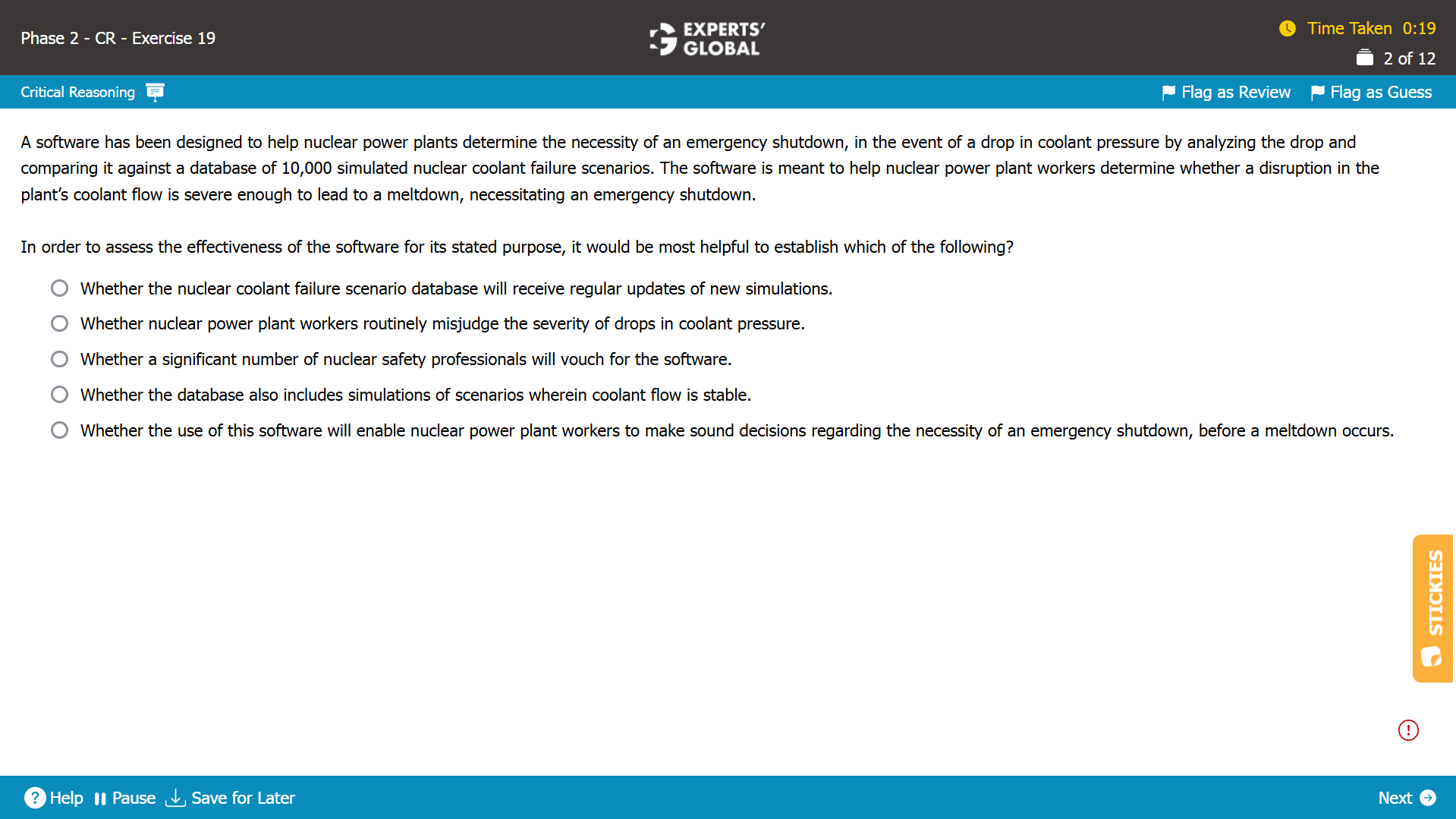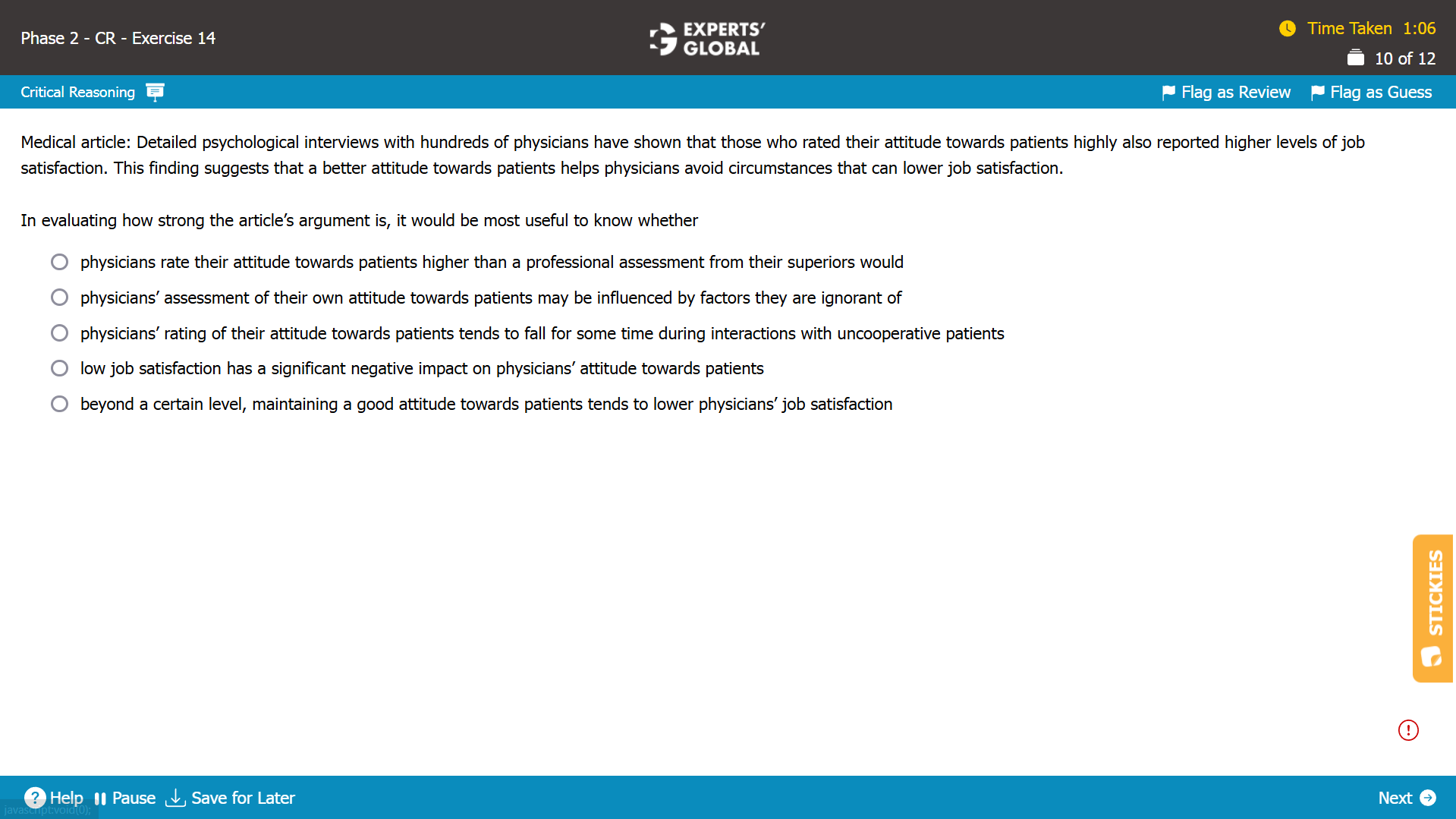Invest 30 seconds...
...for what may lead to a life altering association!
Help Line
- +91.8800.2828.00 (IND)
- 1030-1830 Hrs IST, Mon-Sat
- support@expertsglobal.com
...for what may lead to a life altering association!


GMAT Critical Reasoning Evaluate the Argument (or simply “Evaluation”) questions ask you to identify the information that would help you judge the strength of an argument by showing whether its reasoning holds up or breaks down. They teach you to look for the exact point on which the argument depends and to see how new evidence could change your confidence in its conclusion. Steady practice with this question type is an essential part of any thorough GMAT preparation course. This page offers you an organized subtopic wise playlist, along with a few worked examples, for efficient preparation of this concept.
Evaluation questions seek the piece of information that would best test the connection between the evidence and the conclusion. This overview offers a practical lens: first, pinpoint the likely gap in the reasoning, then ask which fact, if known, would most clearly reveal whether the argument is strong or weak, without itself taking sides. The video introduces this method, while the article arranges common stem patterns and decision checks to guide careful, precise reading. The following short video explains this method, shows it in practice, and prepares you to use it consistently in GMAT drills, sectional tests, and full-length GMAT mock tests.


This section brings together GMAT-style Critical Reasoning Evaluate-the-Argument questions, each paired with a carefully developed, stepwise explanation. Work through every stimulus unhurriedly and put into practice the evaluation tools and reasoning habits you have just studied on this page for such questions on the GMAT. At this stage, give higher priority to applying the analytical framework accurately than to simply choosing the option that appears correct. After committing to an answer, use the explanation control to reveal the credited choice and to read the full, descriptive reasoning behind it.

Show Explanation

Written Explanation
Mind-map: Software to determine necessity of emergency shutdown of nuclear power plants → when coolant pressure drops → software compares coolant pressure with coolant failure scenario database → helps determine whether a meltdown is likely and whether emergency shutdown is necessary → software effectively determines necessity of emergency shutdown (implicit conclusion)
Missing-link: Between all the information presented and the conclusion that the software effectively determines the necessity of emergency shutdown
Expectation from the correct answer choice: To indicate some fact or data that helps in evaluating the conclusion that the software effectively determines the necessity of emergency shutdown
A. The argument mentions that the software has a database of 10,000 simulated nuclear coolant failure scenarios; regular update to the database may, at best, marginally improve the existing effectiveness of the software and makes no suggestion about whether the software is effective “to begin with” in the first place; so, this answer choice would simply provide operational detail but fail to help in assessing the effectiveness of the software. Because this answer choice would not help evaluate the conclusion, this answer choice is incorrect.
B. Trap. Routine misjudgment of the severity of drops in coolant pressure indicates that a new method of judgment is necessary and makes no suggestion regarding whether the software will accurately judge the severity and effectively determine the necessity of emergency shutdown; so, this answer choice would simply provide additional information but fail to help in assessing the effectiveness of the software. Because this answer choice would not help evaluate the conclusion, this answer choice is incorrect.
C. Endorsement by nuclear safety professionals indicates that the software is supported by experts and makes no suggestion regarding whether the software will effectively determine the necessity of emergency shutdown; so, this answer choice would simply provide operational detail but fail to help in assessing the effectiveness of the software. Because this answer choice would not help evaluate the conclusion, this answer choice is incorrect.
D. Trap. The aim of the software is to determine whether a disruption in the plant’s coolant flow is severe enough to lead to a meltdown; the argument mentions that the software has a database of 10,000 simulated nuclear coolant failure scenarios; so, knowing whether the database also includes stable coolant flow scenarios has no bearing on the argument and fails to help in assessing the effectiveness of the software. Because this answer choice would not help evaluate the conclusion, this answer choice is incorrect.
E. Correct. The aim of the software is to assess the possibility of a meltdown and warn about an emergency shutdown; if the software helps the nuclear power plant workers make a decision before a meltdown occurs, the software can be considered effective; if the software does not help make the decision before a meltdown occurs, the software may not be of practical use; so, knowing whether the software helps take the decision before a meltdown occurs is necessary to assess the effectiveness of the software. Because this answer choice would help evaluate the conclusion, this answer choice is correct.
E is the best choice.

Show Explanation

Written Explanation
Mind-map: Interviews of physicians conducted → physicians with better attitude had higher job satisfaction → attitude helps avoid lower job satisfaction (conclusion)
Missing-link: Between physicians with a better attitude having higher job satisfaction and the conclusion that attitude helps avoid lower job satisfaction
Expectation from the correct answer choice: To indicate some fact or data that helps in evaluating the conclusion that attitude helps avoid lower job satisfaction
Discussion: This argument commits the classic GMAT error of confusing “effect” with “cause”; the argument mentions that physicians with better attitude had higher job satisfaction and concludes that attitude is the “cause” that has an “effect” on job satisfaction; the argument ignores the possibility that job satisfaction may be the cause that has an effect on attitude. In order to establish a cause-effect relationship implied in the argument, the reverse possibility needs to be evaluated.
A. Trap. This answer choice, suggesting that physicians typically rate themselves higher on the attitude towards patients than their superiors would, indicates that all physicians involved in the study are likely to have inflated the ratings of the attitude towards patients; however, this answer choice makes no suggestion regarding the relationship between the attitude towards patients and job satisfaction levels and thus would not help evaluate the conclusion. Because this answer choice would not help evaluate the conclusion, this answer choice is incorrect.
B. Trap. This answer choice, suggesting that there are other factors that affect the attitude towards patients, or the perception thereof, is applicable to all physicians regardless of their attitude towards patients and job satisfaction levels; so, this answer choice fails to make any suggestion regarding the relationship between the two; hence, this answer choice does would not help evaluate the conclusion. Because this answer choice would not help evaluate the conclusion, this answer choice is incorrect.
C. Trap. This answer choice, suggesting that interactions with uncooperative patients temporarily affect physicians’ attitude towards patients, is applicable to all physicians regardless of their attitude towards patients and job satisfaction levels; so, this answer choice fails to makes any suggestion regarding the relationship between the two; hence, this answer choice does would not help evaluate the conclusion. Because this answer choice would not help evaluate the conclusion, this answer choice is incorrect.
D. Correct. This answer choice, suggesting that low job satisfaction negatively affects the attitude towards patients, indicates that job satisfaction levels are the “cause” that have an “effect” on the attitude towards patients, thus reversing the cause-effect relationship implied in the argument and casting doubt on the conclusion that the attitude towards patients helps physicians avoid circumstances that can lower job satisfaction; so, this answer choice would help evaluate the conclusion. Because this answer choice would help evaluate the conclusion, this answer choice is correct.
E. This answer choice, suggesting that there exists a high level of the attitude towards patients that tends to lower job satisfaction, indicates that, in some cases, attitude does not help avoid lower job satisfaction, thus weakening the conclusion; however, this answer choice is applicable only “beyond a certain level” and is thus, limited in scope; hence, this answer choice makes no suggestion regarding the generally-applicable relationship between attitude towards patients and job satisfaction levels and thus would not help evaluate the conclusion. Because this answer choice would not help evaluate the conclusion, this answer choice is incorrect.
D is the best choice.
High quality CR Inference questions are not available in large numbers. Among the limited, genuinely strong sources are the official practice materials released by GMAC and the Experts’ Global GMAT course. Within the Experts’ Global GMAT online preparation course, every CR Complete the Paragraph question appears on an exact GMAT like user interface that includes all the real exam tools and features. You work through more than 300 CR Complete the Paragraph questions in quizzes and also take 15 full-length GMAT mock tests that include several CR Complete the Paragraph questions in roughly the same spread and proportion in which they appear on the actual GMAT.
All the best!